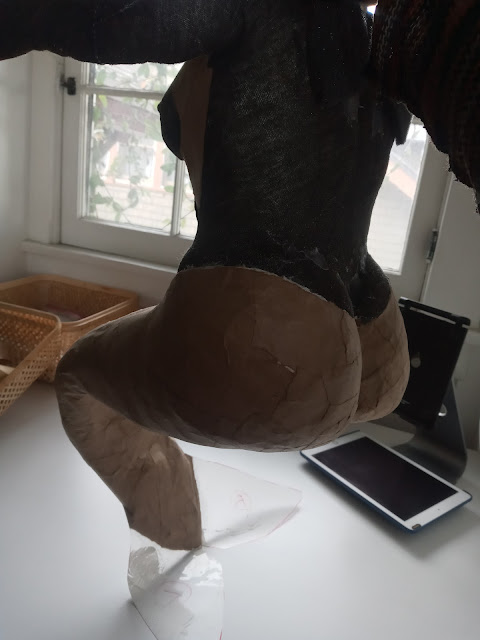30 Years and a Month: Making of Final Large Kyra Puppet
The mold was made from my 1993 original clay sculpt (seen in photo at bottom). I still had the large molds for her head, arms, and tail, but the torso was gone for good. I finished the puppet head fully a few years ago but Resupping is actually working (!) and I have now completed her entire body, including re-creating her torso, this time in a build-up style. I didn't have the gumption to re-sculpt, re-mold, and re-cast what was lost but I'm very happy to have taken a new route to getting this puppet finally done, 30 years later.
I took a salvaged metal gas line hose, cut it in half, and wired the ends into a neck and shoulders. I scavenged the recycling for a small cardboard box that was creased and cut into torso contours and held together with masking tape. Once the body form was assembled from various packaging, it was sheathed in thrifted poly fiberfill. This reminded me of my early soft-sculpture days when 8" doll needles were used to sculpt fiberfill and layers of nylon stocking into life-sized figures of people. (Inspired by the uncanny talent of Lisa Lichtenfels, I used to make these and dress them in fun vintage clothing and position them around LA. One of an old woman in a bird-decorated hat in an old wool coat and eating an ice cream cone made it into a dimensional illustration compilation book.)
Unlike more malleable clay sculpting, build-up puppet style is often more of a back-and-forth process of adding shapes and carving away with a knife until it's as you would like it. Upper right, I added anatomy topography from cut foam with hot glue before covering the finished form in glue-soaked stretch knit jersey fabric pieces to unify.
Once the glue dried, the pins used to help shape the cloth to the form were removed and adjustments continued, back and forth over several sessions. It took a lot of physical power to crush the cardboard shapes and get the giant needles through to lock down the revisions. This must be what plastic surgeons feel like sometimes just absolutely brutally forcing bodies into the shape they want. Very unlike plasticine clay work which feels much easier to control with smaller changes.
With the re-created torso finally done, I set about re-making her tail to suit. I scraped the previously made tail for a much improved shape after making the smaller version.
I did this in the least taxing way possible, as I so often do as this project is a marathon sprint. I simply took packaging paper and roughed a tail shape to size and mummied the whole thing in masking tape. Further back and forth, adding a suggestion of thighs near the human hips that fade gently into a deliciously un-humanlike fishtail.
Her arms were to be cast from the original molds in a slightly different process, build up vs. cast, but built up from the outside of the shape to embrace the armature inside. Back-filled Build-up, if you like.
Lower right shows the completed forms of body and tail during the paper mache skin coat process. Because the finished head and face have an unmistakable paper effect, the entire 4-foot puppet has to inhabit that same aesthetic.
Look for how I finished her new tail in my fishnet texture technique with unusual special effect paints to match her alter-animatable version of herself.
That reminds me to mention that this large puppet appears in only one sequence of the film. In the very first shots, shot in live-action at a nearby beach, the large mermaid is the first Halfland character we see. There is no animation, only very minor pose changes. It's for two important moments that start the audience's journey though, one where Kyra turns her head toward us and makes a single sound of exhalation, "Poe" with her mouth. That sound is like an enchantment of sorts where we leave this world and reemerge in Halfland.
The next montage we see her tail disappearing under the water of the ocean. (Yes, I have made a third rod-puppet tail for water stunting and have a cheap 4K video action camera with waterproof housing.)
So, no animation armature was needed for this scale puppet beyond simple wire. Upcoming posts will however share the exciting actual stop-motion armature successfully engineered for the smaller Kyra.
Photo of original sculpts for Kyra, the large was first and my first-ever sculpture.
The maquette in front became the finished scale of the character for animation.




Out of loss comes growth - thanks for the link to Lisa's work - I'm off to have a nosy.
ReplyDelete